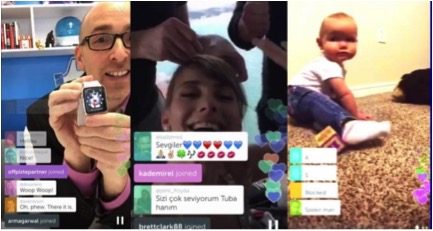
1. Don’t Forget About Your Other Social Channels
Periscope and Meerkat are both incredibly powerful channels through which you can tell your story. Reaching your audience live, with the opportunity for them to respond in real time, provides limitless opportunities. But both of these apps are stronger when you use them in combination with other channels.
Let’s think through an example. Say you want to introduce a person who has been helped by your nonprofit. You want to show the impact your work has made in this person’s life. So you decide you’ll live stream a conversation. The conversation itself will be incredibly powerful, especially if viewers join the conversation with their own questions or thoughts.
But think how much more powerful it could be if you use Twitter and Facebook to fill out, or gather, the backstory before the stream, allowing your audience to feel invested in the story before your stream even begins. And imagine how nicely Instagram could show behind the scenes views of your live stream after the fact, giving supporters a way to feel more connected to the characters and details.
When used in conjunction, all of your social media channels can come together to powerfully tell a story.
2. It’s Live But Not Unrehearsed
Remember that although this live stream experience won’t live longer than 24 hours online, it will live much longer in the minds and hearts of your audiences. So don’t confuse “ live” with spontaneous and unplanned.
Plan out your conversation, your story, or your event before you even turn on the camera. Think through what you’ll say, script it out if it helps, and maybe even walk through the motions before you go live. Depending on the type of event you plan to stream, you might consider the following:
- Your opening and closing sentences/paragraphs/points – think these through and even go as far as to write them down so that you start strong and finish just as strong
- Plan for interaction – think ahead to the types of questions/comments/requests you might get from viewers and prepare your responses ahead of time
- Walk through the space where you’ll be streaming and make sure it is ready for public viewing
- Practice your words and steps at least once so you can uncover any potential pitfalls (e.g. words that trip you up or places you tend to ramble)
3. Traditional Storytelling Elements Still Apply
Finally remember that no technology will ever replace good, old-fashioned storytelling elements. Create a narrative thread. Follow a story arc from beginning, to middle, to end. Your characters may be real people but they still need to be relatable and multi-faceted to capture a viewer’s attention. Remember these key components of storytelling that you learned in elementary school:
- Characters – who is the story about, who moves the action forward, who is your protagonist, who is your hero (note – your hero is not always a person!)
- Setting – where is the scene taking place, what is it like there, what happened just before the video begins
- Conflict – what is the problem to be solved, what must the characters (or viewers) overcome
- Resolution or Call to Action – what wraps up the story or, what should the viewer do next
Your goal with storytelling is to create an emotional connection with your supporters. When planned and structured well, Periscope and Meerkat can be powerful ways to connect and engage.




